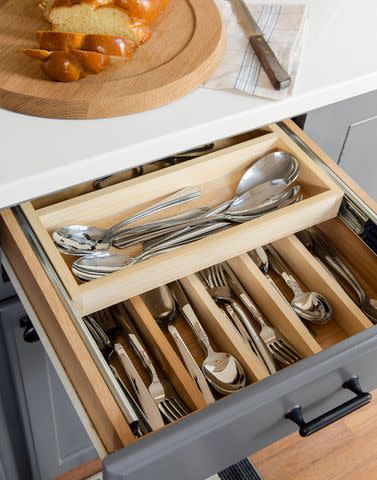How to Clean Silverware to Protect Against Stains and Tarnish
Use these natural cleaning methods to protect your flatware and keep it looking polished.
Silverware is an essential part of any place setting, but when it comes to cleanup, flatware is often treated as an afterthought. Many of us simply load our forks, knives, and spoons into the dishwasher and press start, but that's often not the best way to clean your cutlery.
We'll show you how to clean silverware in a variety of finishes using natural household ingredients, including how to properly dry and store the pieces when you're done. Use these easy tips to keep your flatware spotless and preserve its shiny finish.

How to Clean Silverware
For cleaning tips specific to your silverware's finish, check the manufacturer's instructions before you begin.
Step 1: Remove Food Remnants. Always remove any food remnants as soon as possible to avoid stubborn buildup or rust, and don't let cutlery soak for long periods of time.
Step 2: Hand-Wash Silverware. Wash silverware, including sterling silver, stainless steel, and plated pieces, in warm, soapy water by hand using a soft sponge.
Step 3: Dry and Store. Once clean, dry the silverware immediately with a soft cloth to prevent water spots. Store your flatware in a dry, cool spot that's clean and protected from dust.
Tips
When cleaning silverware, avoid using scouring powders and abrasive tools such as steel wool and stiff-bristled brushes, which can scratch or remove the finish.
How to Clean Stainless-Steel Silverware
Stainless-steel silverware is prone to streaks, water spots, and rust. Follow these steps to avoid these problems.
Step 1: Rub with Olive Oil. To restore the shine of stainless-steel silverware, use a soft cloth or dish towel dampened with olive oil to gently rub away blemishes and discoloration.
Step 2: Remove Tarnish. Lightly dampen another cloth with distilled white vinegar and buff in a circular motion to remove any tarnish.
Step 3 (Optional): Remove Rust Spots. For pesky rust spots, mix baking soda and water to form a thick paste. Gently rub the paste onto the rusted areas with a soft cloth.
Step 4: Rinse and Dry. Rinse with clean water and dry immediately.
How to Clean Silverware with Plated Finishes
You can now find flatware in a wide variety of metal tones, including gold, silver, matte black, rose gold, and more. These pieces are typically made from stainless steel with a plated finish, which can scratch or wear off without proper care.
Never wash plated silverware in the dishwasher or submerge it in a liquid solution for extended periods. Avoid acidic cleaning agents including lemon juice and citrus-scented detergents, which can pit the surface.
Step 1: Wash Plated Silverware. Wash plated silverware by hand with a soft sponge, mild dishwashing liquid, and warm water.
Step 2: Rinse and Dry. Rinse off the silverware and dry immediately.
How to Clean Sterling Silver Silverware
Silverware made from real sterling silver tends to tarnish over time. Follow these steps to make the silver shine like new.
Step 1: Add Silverware to Cleaning Solution. Line a pot or roasting pan with foil and fill with boiling water. Stir in 1/4 cup baking soda and 2 tsp. kosher salt, then carefully add your silverware.
Step 2: Let Cool and Dry. Let sit for five minutes. Once cool, remove the silverware from the cleaning solution and dry thoroughly.
Step 3: Remove Water Spots. To remove water spots on sterling silver silverware, use a soft cloth dampened with lemon juice to gently polish the surface.
Can I Clean Silverware in the Dishwasher?
Dishwashers use extra-hot water and powerful detergents to cut through grease and stuck-on food on your dishes, but these harsh cleaning methods can cause discoloration, mar the finish, or leave unsightly spots on your silverware. Especially for pieces made from real sterling silver or plated with a special finish, a gentler cleaning technique is essential to ward off damage and stains.
For more Better Homes & Gardens news, make sure to sign up for our newsletter!
Read the original article on Better Homes & Gardens.
